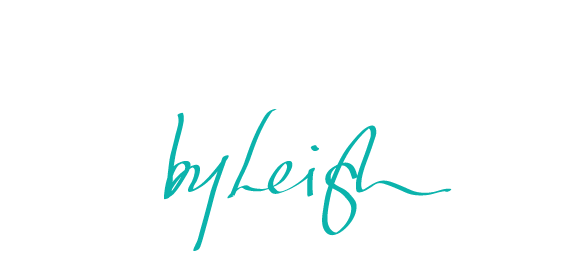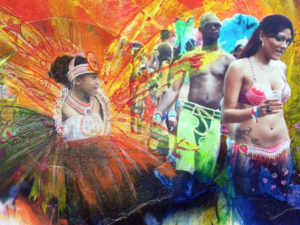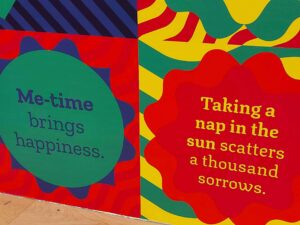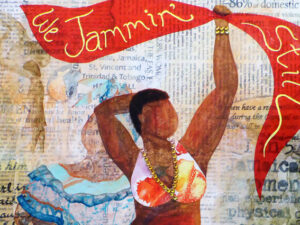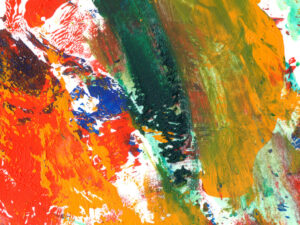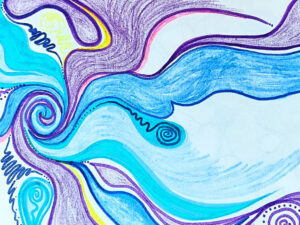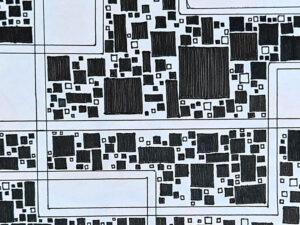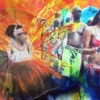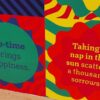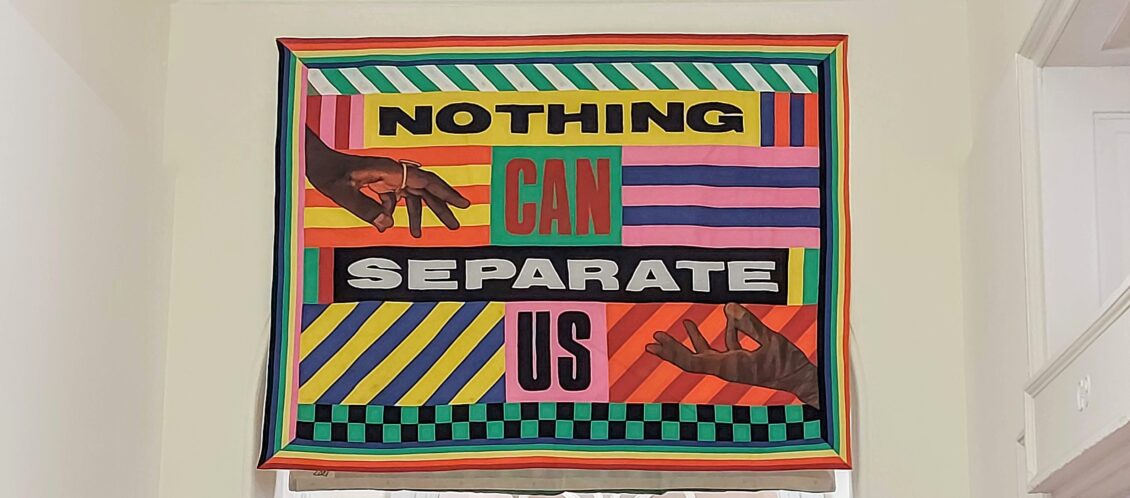
Featured Art: Nothing Can Separate Us by Lakwena Mciver (as seen at The African Art Fair 2021, Somerset House)
16 Oct 2021
The LCC PhD candidates were invited to meet and get to know each other with a little field trip to the African Art Fair at Somerset House and the Frieze Art Fair in Regents Park. I had never been to either of these before and although the names sounded like I’d heard them somewhere, I knew next to nothing about either fair until I got there. For all intents and purposes, I went into both completely blind.
Talk about chalk and cheese!
The African Art Fair
When we entered Somerset House, the stewards greeted us warmly, welcomed us in and asked which exhibition we were here to see. We were directed accordingly and after that all interaction with Somerset House staff was a warm customer service experience.
Once inside, it took me a moment (not having been to an Art Fair this size before) to realise that each room was a different gallery, manned by the gallery’s agents, showcasing a few of their ‘top’ artists. I say ‘top’ because who knows what criteria each gallery used to decide who should be seen. The agents in each room/gallery were as diverse as the art. There were agents of various races, sizes, genders (possibly including some possibly non-binary agents too). They wore everything from jeans to suits to dramatic evening wear. Frankly there was an agent whose outfit was itself a work of art. So much so I had to stop to compliment them on how fabulous it was!
Anyway, as we moved through the Fair, I enjoyed seeing so many different representations of Black culture and life. The mediums, styles, and experiences captured were as varied as the nationalities of the gallery agents. There were massive portraits made with nails by Alexis Peskine, stitched quilts with love messages (Lakwena Mciver), stained loose leaf paper collages in earthy tones, digital art representing joyful Black masculinity, colourful transparent nylon (like pantyhose) so cleverly stretched across an orange canvas that it looked like paint (Tureya Magadlela)!
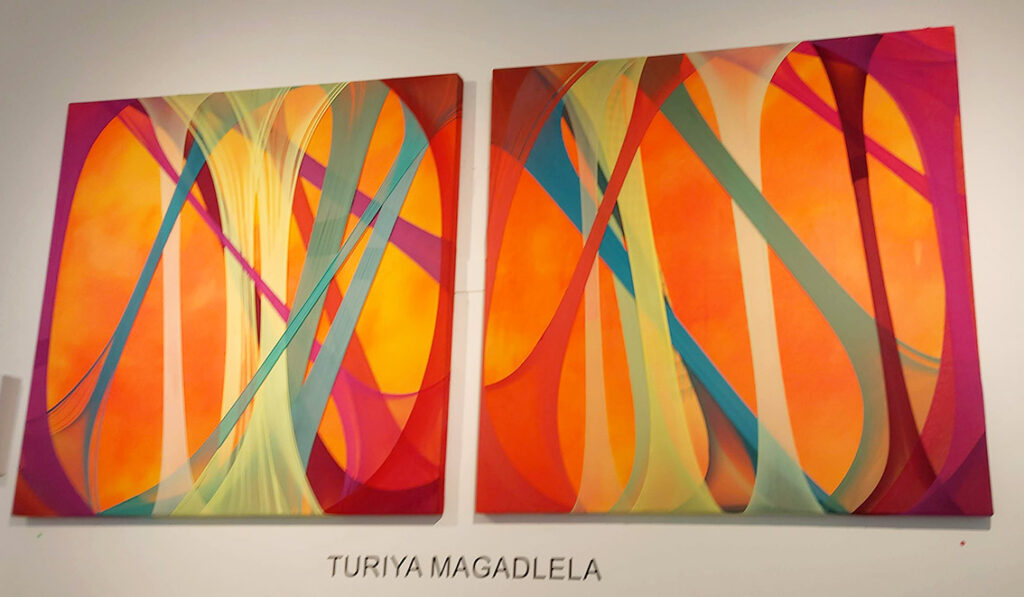
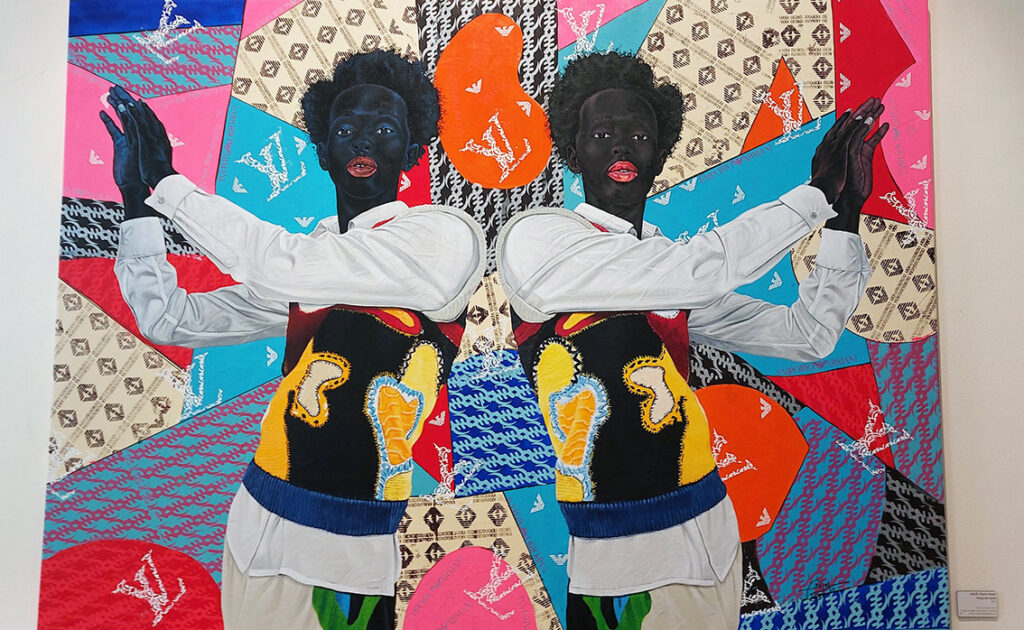
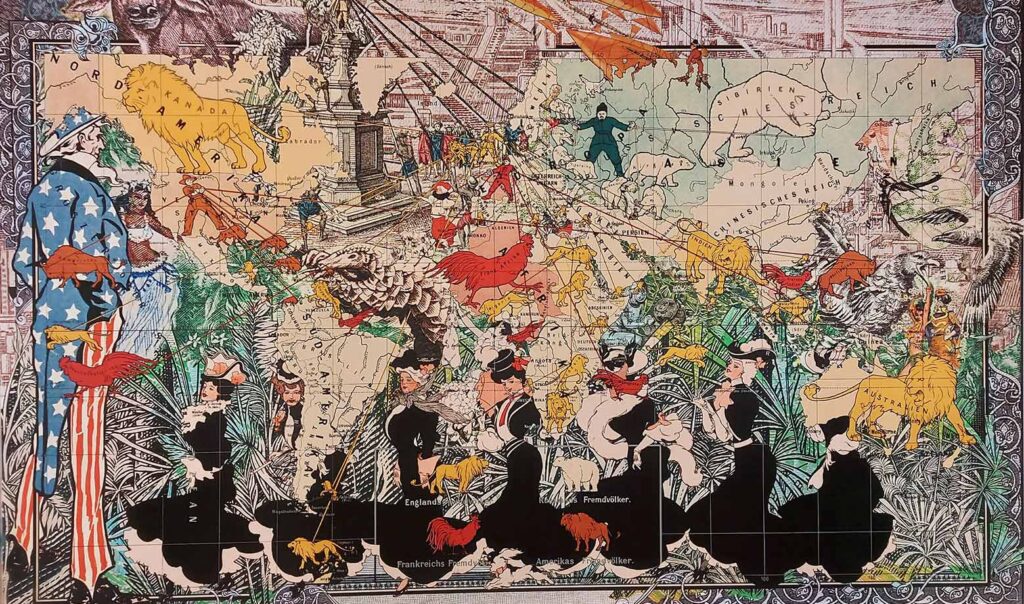
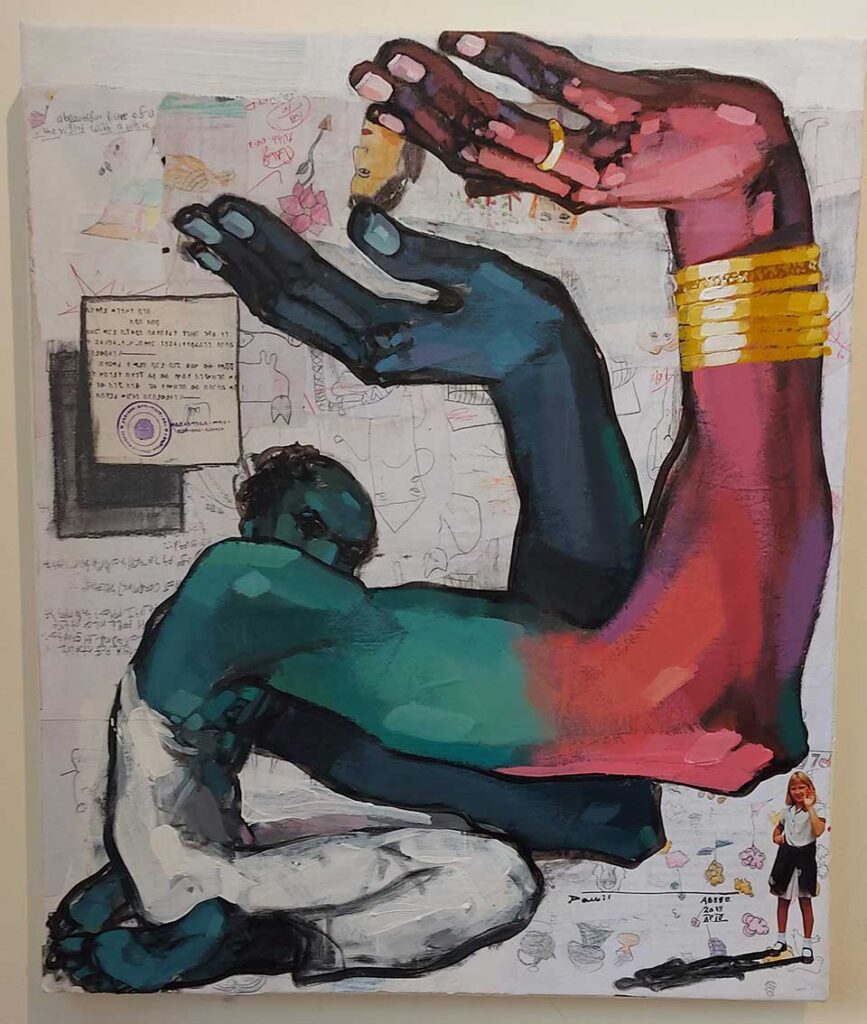
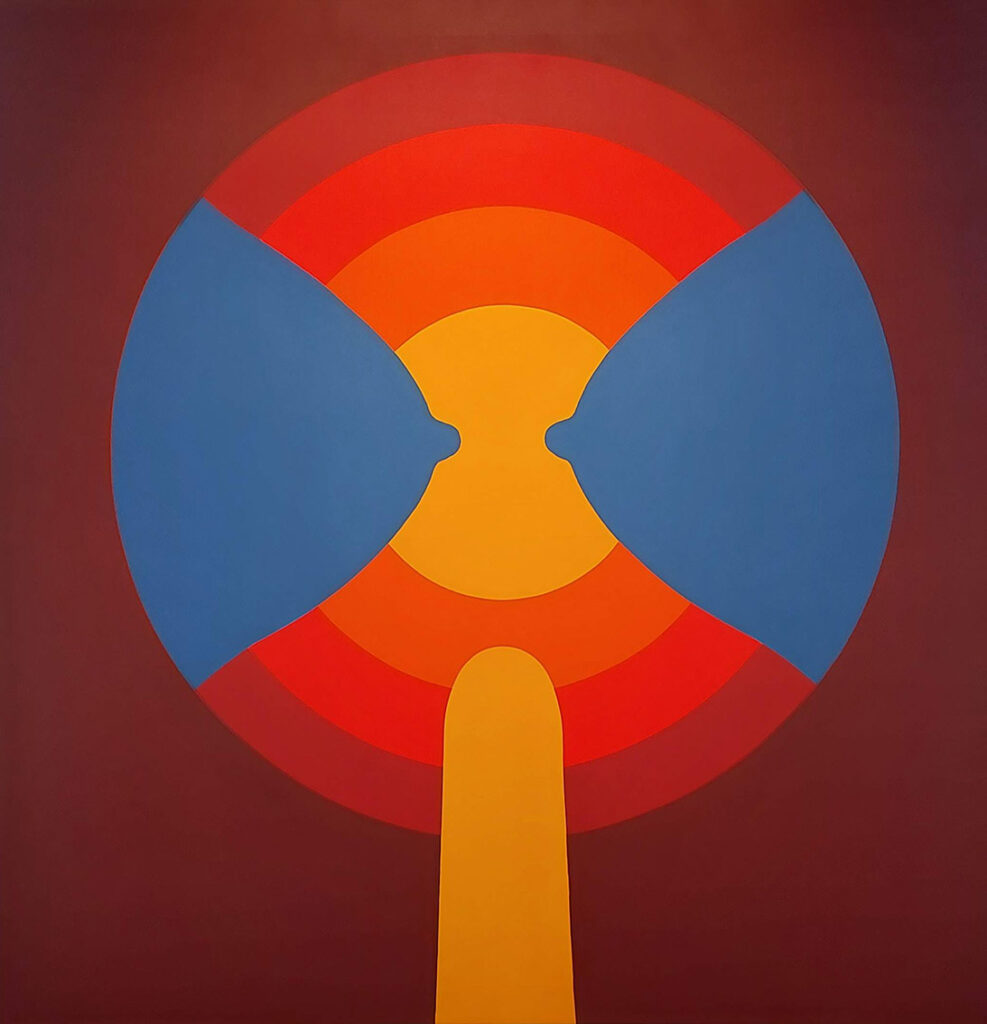
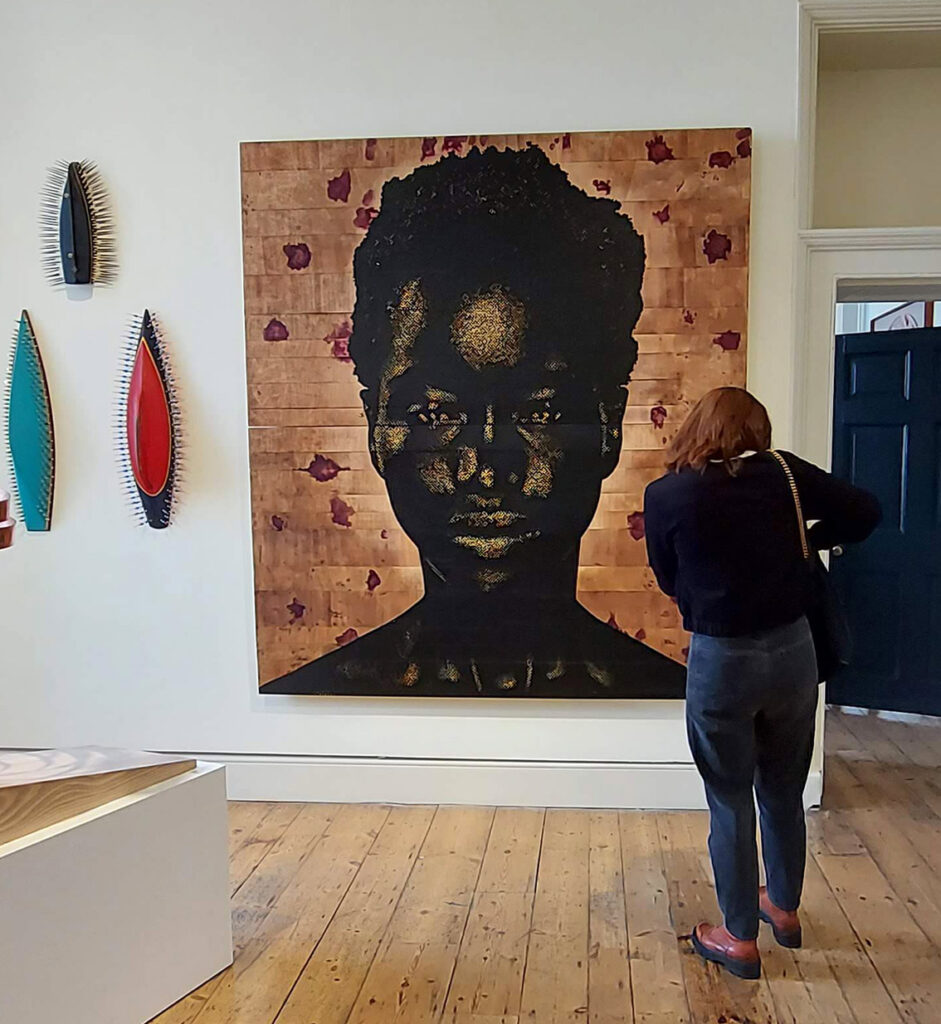
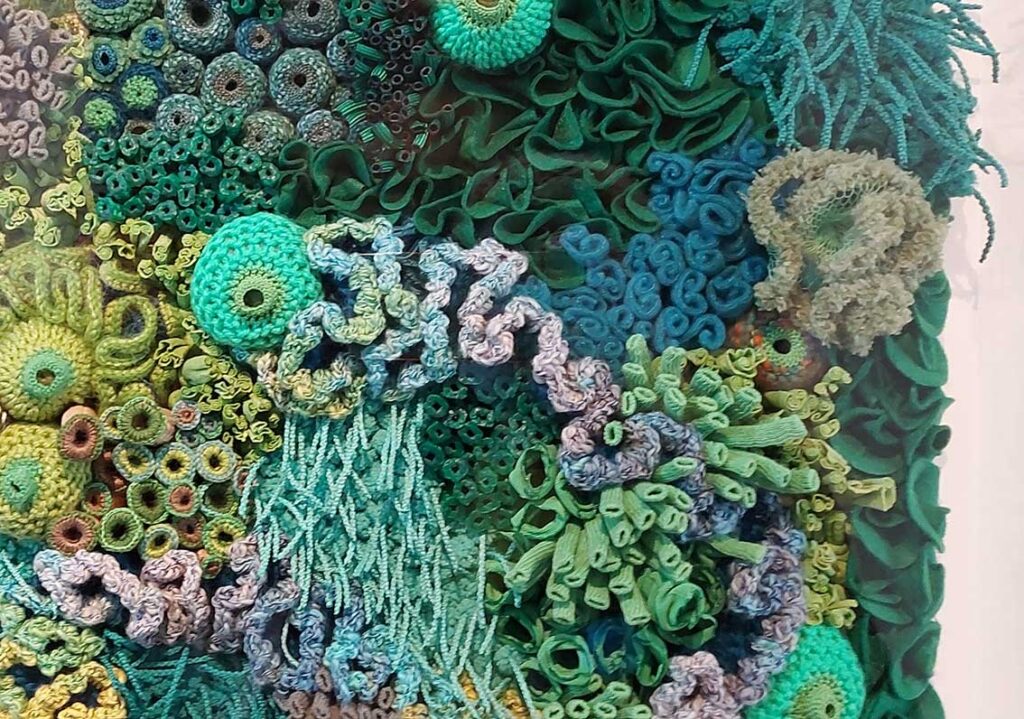
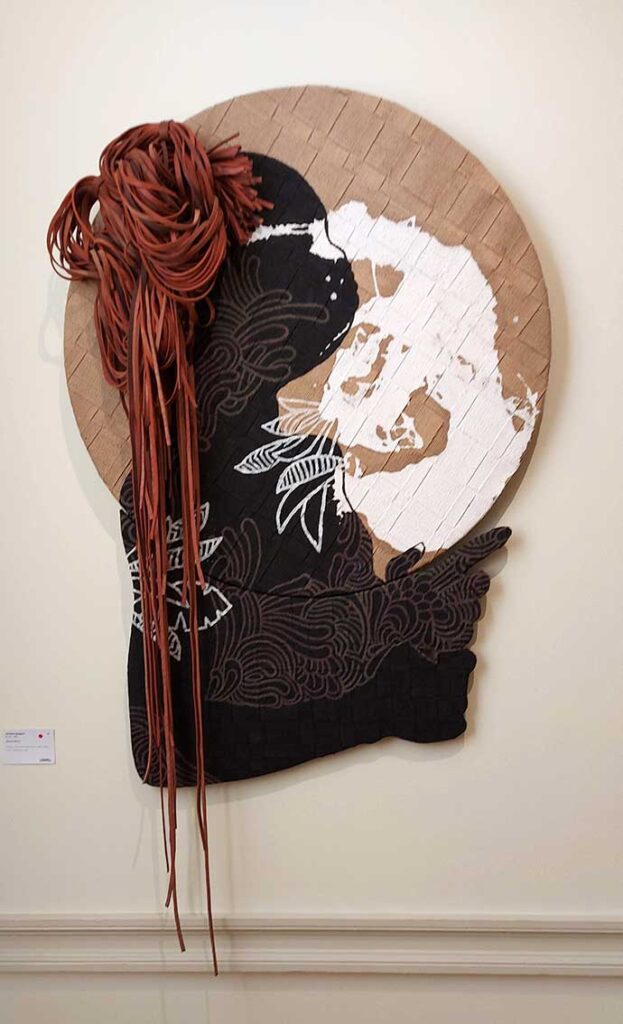
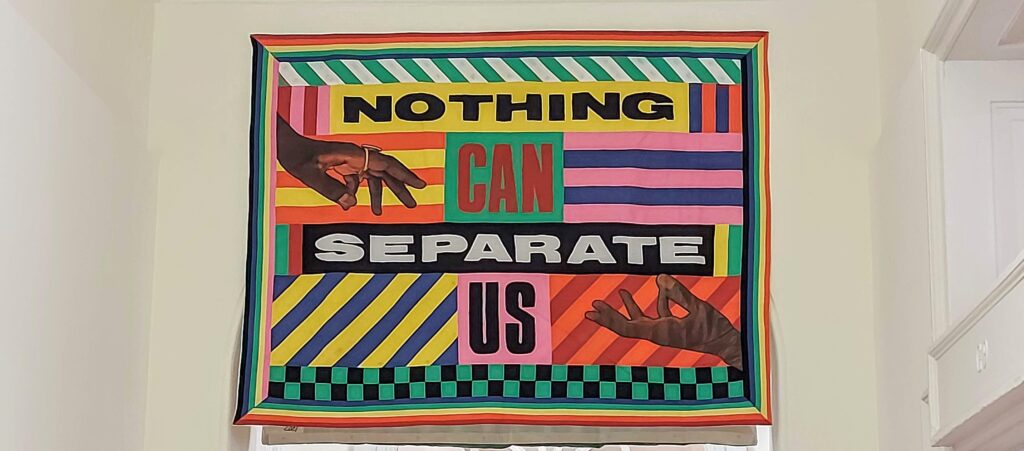
There were paintings on cocoa and sugar burlap sacks (oh the history!), and paintings that imagined Black faces in white spaces. There were crocheted, woven reefs in full colour, then bleached white as the real reefs of our world have lost their colour. There were boldly coloured phallic and fertility symbols, and massive portraits of Black people made by driving nails into brown stained wood and painting the nail heads silver. Multiple representations of Black femininity from old to young, powerful to abused, burdened to free with wild abandon. At one point, I stood with 2 strangers in front of a mixed media collage discussing the symbolism in the painting until we finally pieced together that it showed a visual history of empire across the globe. Once we saw it, we all paused in silence for a moment, all a little awed, I think.
It was particularly poignant seeing Black art afforded the same respect that old white gets in a space like Somerset House. I felt like I was in the midst of “live” decolonisation, and it was beautiful to watch a message of – Black talent is recognise and welcomed here – play out with everyone from the Somerset staff, to the agents, to the audience, and even with some of the artists who were there with their work!
Looking around, the patrons seemed to be excited, happy and despite the crowd there was a sense of welcome and warmth among the people. At times, my eyes met a few people, and we smiled at each other before moving on, despite being perfect strangers. I struck up wonderful conversations here and there with gallery agents whose work intrigued me. One agent and I even ended up looking up images of Adventure Time characters on our phones as her artist’s stunning wooden sculptures reminded me of a few of the cartoon’s characters.
The only fly in the ointment was an agent who might have been better suited to Frieze. All puns intended.
One of the other LCC candidates and I walked into a room in time to hear this agent dismissively telling a young artist who was asking about representation that “We only represent South Africans!” Now it may be true that the gallery only represents South Africans but his tone was clipped, sharp, imperious, and just the wrong side of irritated as he looked down his nose at her. The work around him was beautiful BUT if I had the money I’d never spend it with him seeing the way he treated that artist. This was as close as the African Art Fair got to the atmosphere at the Frieze.
To be fair to Frieze, there was a lot to see at the African Art Fair so maybe our PhD crew were just “over-arted” by the time we got to them but I don’t think that was the main cause of my (or the other candidates’ ennui) with Frieze.
Frieze Art Fair, London
When we arrived at Frieze, I found it was being hosted in a giant marquee that seemed to have popped up in the middle of Regents Park. Ok, so the entire fair was like a temporary art installation of sorts. Cool!
Unlike the multiple entrance points with staff checking your tickets at Somerset House, there was one entry point to Frieze, and you went through various security points. I’ll absolutely give them points for checking my ticket, my vaccination card, and that I was wearing a mask. They said they would be taking strict precautions against Covid and they lived up to it. Somerset House had not been that stringent. Having met all the requirements, I received my black and silver arm band to prove that I was “approved”.
Once a few of us got past the first security point, we turned back to wait on the others in an open area right after that checkpoint. It was a wide-open space in front of a humongous Frieze sign, a bit reminiscent of where stars pose on red carpets to prove they were at an event because all the event logos and names are on the wall behind them.
Frieze patrons, gathered there to strike a pose and snap a pic before a giant of a man in a bulky black suit and an earpiece moved them along. This might be the closest I ever get to the Hollywood red carpet vibe. Our ‘handlers’ for the day, who had organised this field trip, wanted to get a photo of all of us in front of the oversized Frieze Art Fair sign. They managed it moments before Mr Celebrity Security dude asked us to politely but firmly “move along”.
Next we joined a long line that snaked up a ramp. It was so long it doubled back on itself! Thankfully the line was moving and soon we were up to a shorter more muscular man in bulky black suit, also wearing an earpiece.
“Form an orderly line and ensure your armband is clearly visible!”
I can’t remember if he threw a ‘please’ in there or not. The poor man was shouting this over and over and over so I suspect there was no ‘please’. He was not smiling. Neither were the other 4 celeb-style guards we passed before we got to the front door. Already, my peers started commenting,
“This is a completely different vibe from the African Art Fair”
I couldn’t agree more. I felt like I had been inspected, approved, and herded into a space that I was beginning to doubt I even wanted to enter. Around me, many people were dressed to the nines with flawless make-up, and brand names glistening off them from their heads to their toes. I am sure I appeared in the background of many a selfie looking a tad confused, wary and curious. I swear I didn’t try to photo bomb anyone. It was hard to escape, the selfie sticks and upraised mobile phones were everywhere!
Finally we reached the door alongside this impressive pristinely white marquee. It took us maybe 15 minutes to get from checkpoint 1 to here. My arm was still upraised, making my armband clearly visible, as instructed. Here, I saw the first female celebrity security guard. She was only slightly smaller and curvier than her counterparts. Her eyes flicked to my armband before she blessed me with the first smile I’d had from any Frieze official. Then she waved us in, instructing us to get out our tickets. Inside the marquee there was maybe another 60 metres (200 ft) of queueing and security checkpoints, but the Frieze team was very efficient and the line moves fast. I got another smile from the lady who searched my bag before sending me on my way. Then finally, finally, we were in!
There were walls upon walls of art with wide walkways between these temporary gallery spaces. Some artworks caught my eye immediately. There were some large colourful pieces that reminded me instantly of Caribbean energy, unfortunately I didn’t manage to snap a pic of the artist’s name.

Another piece with a line-up of multiple images and a notebook was set in a mirrored frame and mount which fascinated me. Why use a mirror? Was this about self-reflection? Was the viewer to reflect while reading and viewing the artist’s reflection? Another piece used black thread on a white canvas to create intricate shapes and patterns in alternating dense and sparse patches (Chiharu Shiota). Yet another used what looked like various pieces of mount card cut into random and irregular shapes layered upon each other in a box frame to create a cool abstract (Erin Shirreff). As with the African Art Fair, the techniques, styles and mediums on show at Frieze were wonderfully varied. So varied that at times, I wondered whether the art went through as strict an entry process as the audience. The worst of these offenders (in my opinion) was the rotten banana taped to the wall with a strip of duct tape. (I really hope that was a spoof.)
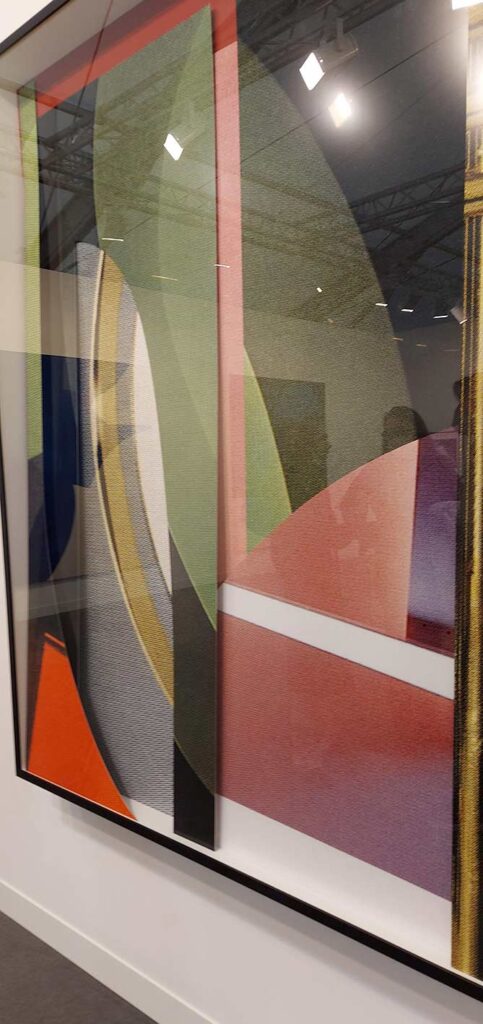
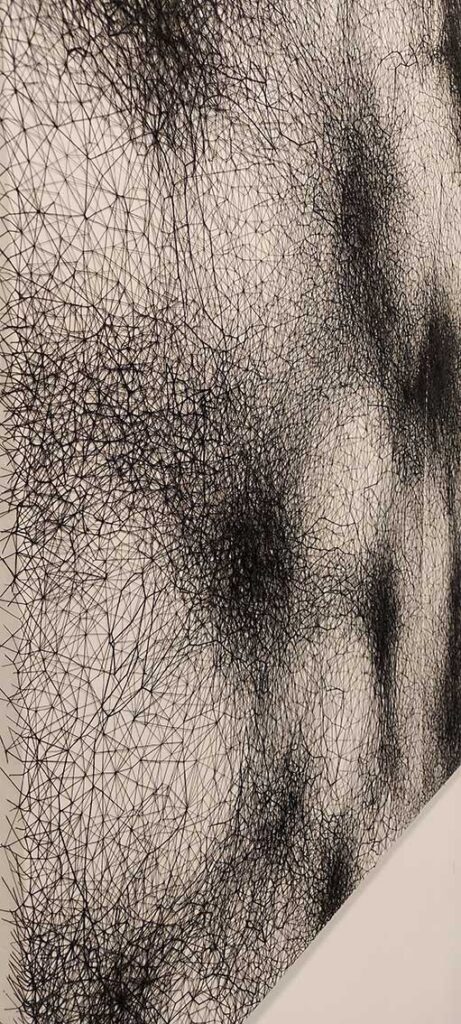
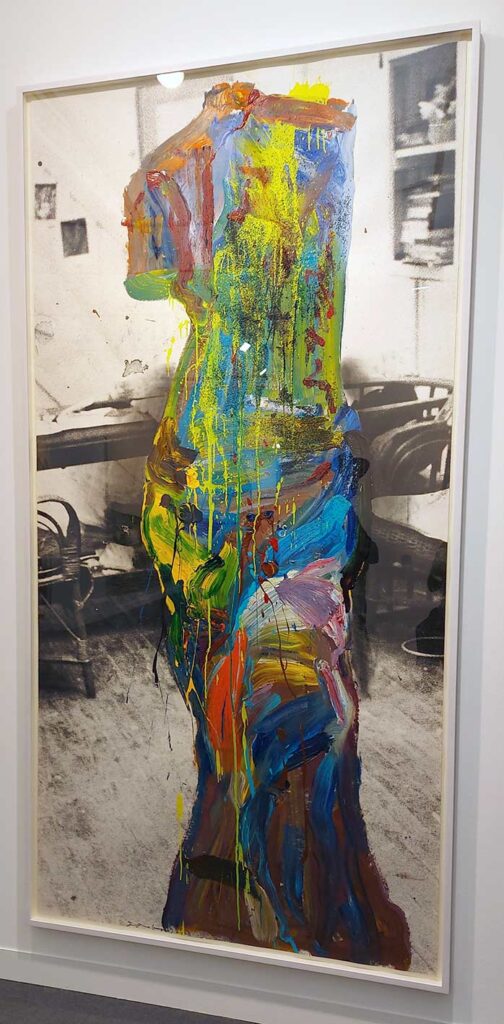
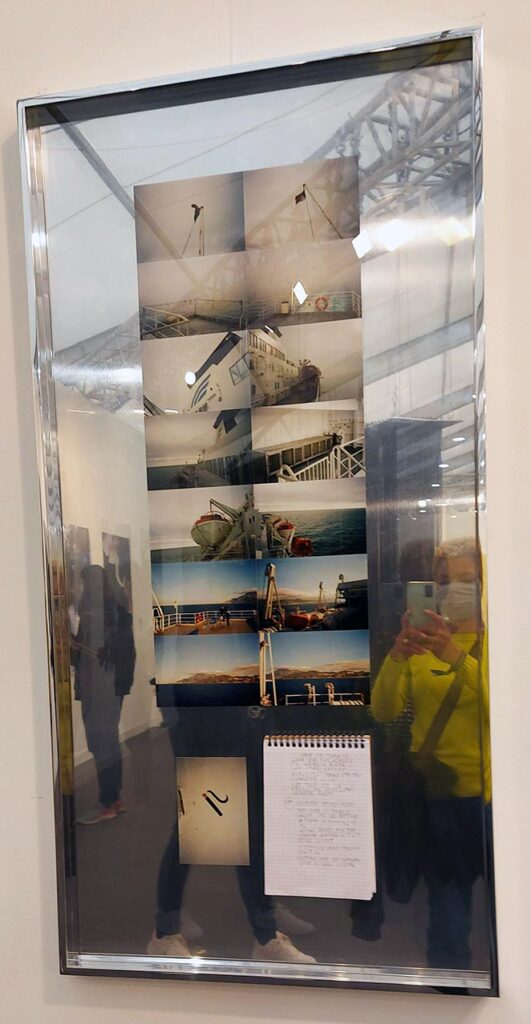
Perhaps the biggest indicator of my malaise with Frieze was how little I pulled out my camera. A fellow doctoral candidate told me she’d promised to take pics of the most ridiculous pieces for her roommate. I knew nothing about Frieze before coming but that comment alone told me, the banana-esque art might not have been a spoof. Wow!
Strolling from one section of the gallery space to another, we passed a table of art agents all head down on their laptops. All white. All slender with carefully coiffed straight or slightly wavy hair. All in suits or suit jackets with jeans. All with immaculately polished tailored-looking shoes. All on tiny expensive looking laptops. None of them looked up, not even once. While my colleague browsed the walls around them, I was so fascinated I kept my eyes on them as people milled around. Not one agent looked up, nor did they speak to each other. I guess sales must have been rolling in… or they just wished to appear unapproachable? Or worse, did the sheer number of people traipsing through intimidate even these hardened agency veterans? Maybe none of the above but I do remember thinking, even the derisive agent from the African Art Fair might struggle here.
In the end, I left Frieze (after being searched again) feeling like I never wanted to return. I was obviously not the target market. When I go to an exhibition, I’m going to see the art and experience a creative journey, not to see and be seen. I could not detect a visual story in Frieze and I was left wondering if we went to Frieze first, would I have appreciated it more? Or would its less cohesive collection make me appreciate the African Art Fair more?
In Summary
| African Art Fair | Frieze Art Fair | |
| Thoughts about The Space | Felt like a “Reclaimed” colonial space, which added meaning Welcoming Approachable Incited curiosity – what’s around this corner? | Temporary Manufactured Neutral A course to get through |
| Thoughts about the Collection | The common thread of Africa/Blackness meant that despite the numerous galleries, the pieces hung together under a theme. Perhaps that made each piece feel more meaningful, grounded in culture and representation (maybe due to my position and experience as a Black female immigrant – my position and my bias) More tactile work (though I couldn’t touch it) Pushed boundaries of concepts, materials techniques, social statements Sales: More red dots | Random. Some pieces felt juvenile, under-developed, like my Form 2/Year 8 or 9 artwork. They didn’t feel like the watery paint, the poor shapes, composition, use of colour, etc was serving a greater purpose. Other pieces were obviously from highly skilled and talented artists. Loved the experimental nature of some pieces, just wish I understood their context as that might make them even more meaningful. Sales: Did they not use red dots? Odd, in such a seemingly performative space. |
| My User Journey Experience | Flow of visitors in opposing direction due to 2 entrances on either end of the building. Covid-wise this seemed unwise, but every room had windows which were open. Info: Some rooms had QR code or paper catalogues. Some had info next to the paintings on a label. Some had nothing. Audience: families, couples, groups of friends, all ages though few very young children | Once into the exhibition, you were free to start wherever you liked. Info: Maps via QR code. Basic painting info via label. Audience: couples, groups of friends, mainly late teens to 30s? |
| Take Away Feelings | Approachable Meaningful Celebratory Tired but Happy | Fad-ish Showy & Shallow Performative Exhausting |
| Take Away Thoughts | Celebration of creativity & culture. Just the name African Art Fair and having it hosted in Somerset house created a context. | No real context to add gravitas and meaning to the collection and the experience |
Stacey Leigh Ross attended both Art Fairs in London on 16th October 2021.
